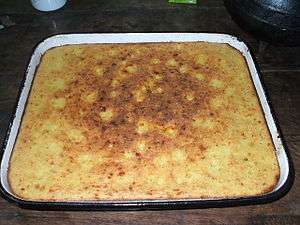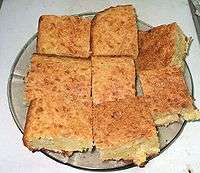Sopa paraguaya

Sopa paraguaya is a traditional Paraguayan and Northeastern Argentine food.[1] Literally meaning "Paraguayan soup", sopa paraguaya is similar to corn bread. Corn flour, cheese and milk or whey are common ingredients. It is a spongy cake rich in caloric and protein content.
According to the Paraguayan folklorist Margarita Miró Ibars, sopa paraguaya is "the product of Guaraní-Spanish syncretism. The Guaraníes used to consume doughy food made of corn or manioc flour, wrapped in güembe or banana leaves and cooked between hot ashes. The Spanish introduced cheese, eggs and milk, which were added to the food made by the Guaraníes..."
Sopa is similar to another corn based Paraguayan typical dish, chipahuazu or chipaguazu, except that the latter is made with fresh corn. The consistency is a little bit more like a cheesy soufflé and less like a savory cornbread. This dish is often served with a Paraguayan beef soup.
History and origin of the name
A story of the origin of the dish involves Don Carlos Antonio López (the founder of the Paraguayan state and president of the country between 1841 and 1862) and one of his cooks (called machú in the Guarani language). It is said that the great governor, a famously obese man, liked a white soup made with milk, Paraguay cheese (fresh cheese), egg and corn flour. One day the machú mistakenly added too much corn flour to the mixture. Near noon, she found herself with two problems: first, the mixture was too thick for tykuetî; second, she didn't have time to start the process over , or replace the favorite dish with another. So, showing off a decided attitude, a mix of fear and wit, she poured the mixture into an iron container and cooked it in the tatakua ("hole of fire", a rustic Guarani oven made of clay and adobe), from which she obtained a "solid soup". Don Carlos, after tasting it, found it very delicious and immediately named it "sopa paraguaya".
Another story, no less credible, says that in ancient times, this food was made with fresh corn and cooked in the ñaúpyvú (clay pot), not in the "modern" oven inherited from the colonizers. Everything suggests that the first Iberians who arrived in Guarani lands called food boiled in the ñaúpyvú "soup". It is believed that finished adding "Paraguayan" (demonym that was used in colonial times to denote the area of the Jesuit-Guarani missions), to distinguish it from the soup (broth) prepared by the Europeans.
Ingredients
To make a traditional sopa paraguaya, you would need ingredients such as onion, water, thick salt, pork fat, eggs, fresh cheese, corn flour, curd or fresh milk, and milk cream.[2]
Other varieties, such as "sopa paraguaya de estancia" use almost the same ingredients, only varying the quantities so as to vary the consistency and make the dish more or less greasy, according to taste.
Preparation
It is said that the traditional preparation of sopa paraguaya follows these steps: The onion is thinly sliced, boiled in salt water for about 10 minutes in a sauce pan, then allowed to cool.

The pork fat is whipped and the eggs are added one by one, continuing the whipping. The crumbled cheese is then added.
The onions with the boiled water are added to the mixture, and the corn flour is slowly added, alternating with the milk and the cream. The combination is mixed until smooth then poured into a greased (with butter or oil) container to be baked in a hot oven (200 degrees Celsius) for about an hour.
References
- "Tembi’u Paraguay" Josefina Velilla de Aquino
- "Karú rekó – Antropología culinaria paraguaya", Margarita Miró Ibars
External links
- Informatik
- Sopa-Paraguaya (recipe). (Spanish)
- Alimentaciòn sana